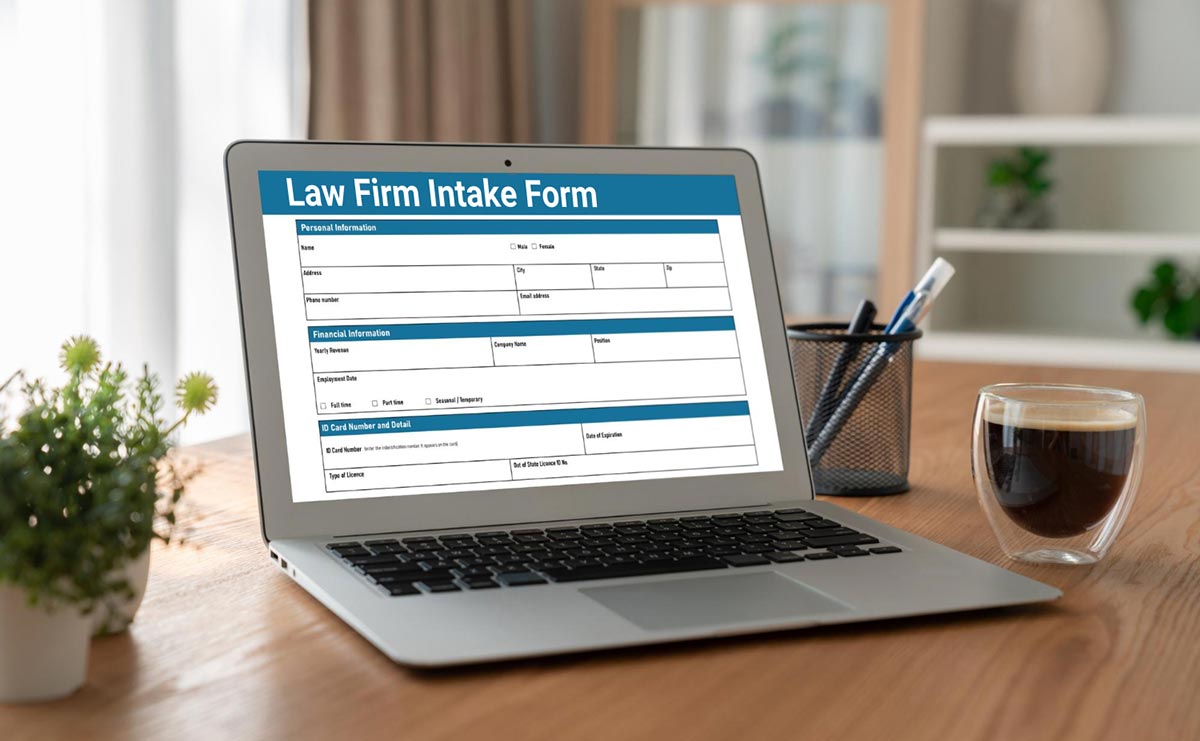Contents
What is the Client Intake Form?
A well-crafted client intake form is a must-have for any successful law firm, serving as the foundation for building strong client relationships and ensuring efficient case management. Whether you are new to practice or burnishing existing processes, being familiar with the key elements of a client intake form can make all the difference in your ability to gather needed data, screen potential clients, and onboard them for tailored legal representation. This form serves as an invaluable means for understanding the client’s needs, background, and the specific details related to the services they are seeking. Creating a client intake form template can streamline the onboarding process and ensure that all necessary information is collected efficiently from the start.
What Is the Purpose of a Client Intake Form?
The primary purpose of a client intake form is to streamline the onboarding process by collecting all necessary information in a structured and organized manner. This ensures that the legal team grasps an overall understanding of the client’s situation from the outset enabling them to provide tailored advice and services.
Key Components of a Client Intake Form
A well-designed client intake form typically consists of several key components:
- Personal Information: This section is a crucial part of our process, as it gathers basic details about you, such as your full name, contact information, address, and date of birth. Your information is integral to the legal process, and we value your contribution.
- Case or Service Information: You play a main role in providing specific information related to the case or services you need including the type of legal issue (e.g., family law, personal injury, corporate law), a brief description, and any relevant dates or deadlines. Your input is crucial and empowers you in your legal situation.
- Client Background: This section may cover questions about the client’s personal or business background, previous legal issues, or any relevant history that could impact the case.
- Referral Source: Law firms often offer a section explaining how the client heard about their services, which can help assess the effectiveness of marketing efforts.
- Confidentiality Agreement: Some forms comprise a clause or a section where clients acknowledge the confidentiality of the information they provide. We want to reassure you that your information is secure and will be handled with the utmost confidentiality, building trust in the legal process.
- Consent and Authorization: Clients may be asked to consent to specific actions, such as collecting and using their information in line with privacy policies or the authorization to proceed with legal services.
Why is Client Intake Important?
The reasons why client intake is so important are as follows:
Establishes a Strong Foundation
Client intake allows the legal team to gather essential information about a potential client’s case, enabling an initial assessment of the case’s merits, viability, and potential challenges. The intake process is often the first interaction between a client and the firm. A well-organized, professional intake process helps establish a positive first impression, setting the tone for the entire relationship.
Improves Efficiency
A structured intake process ensures that all necessary information is collected upfront, reducing the need for repeated follow-ups and saving time for both the client and the legal team. By understanding the specifics of a case early on, firms can allocate resources more effectively, ensuring that the right legal professionals are assigned to the case.

Enhances Client Experience
A thorough intake process helps set clear expectations about the legal process, timelines, costs, and the services the client will receive, leading to higher client satisfaction. Collecting detailed information during intake allows the legal team to tailor their approach to each client’s specific needs, fostering a more personalized and attentive service.
Ensures Legal Compliance
Proper client intake includes gathering signed agreements, consents, and other required documents, securing that the firm is legally protected and compliant with regulations. The intake process helps identify any potential conflicts of interest before taking on a client, safeguarding the firm’s integrity and legal standing.
Facilitates Better Case Management
Intake forms capture all relevant details about a case, which is the requirement for effective case management and strategic planning. The intake process allows the legal team to identify any potential legal issues or complications early in the process, enabling proactive problem-solving.
Improves Client Screening
Intake helps the firm determine whether a potential client’s case aligns with the firm’s expertise and whether the client’s expectations are realistic and manageable. By fully vetting clients during intake, firms can avoid taking on high-risk cases or clients that may lead to non-payment, disputes, or reputational damage.
Supports Marketing and Business Development
The intake process provides valuable data about clients, such as demographics, referral sources, and common legal needs, which can be used to refine marketing strategies and business development efforts. A smooth and positive intake experience can lead to higher client retention rates and referrals, contributing to the firm’s long-term growth and success.
Enhances Communication and Coordination
A well-documented intake process confirms all members of the legal team have access to the same information, improving coordination and reducing the likelihood of miscommunication. The intake process often covers setting up communication protocols with the client, ensuring that they know how and when they will receive updates about their case.
Provides a Legal and Ethical Framework
During intake, clients are typically provided with terms and conditions, fee agreements, and other legal documents that define the scope of representation, ensuring that both parties are on the same page. A thorough intake process helps ensure the firm adheres to ethical standards, including confidentiality, transparency, and fairness.
Lays the Groundwork for Successful Outcomes
With all necessary information gathered during intake, the legal team can develop a strategic plan for the case, increasing the chances of a successful outcome. A well-handled intake process builds trust between the client and the legal team significant for effective collaboration and a positive attorney-client relationship.
Benefits of Using a Client Intake Form
Using a client intake form offers several significant benefits for law firms and legal professionals. These forms streamline the gathering of essential information from clients, ensuring that the initial interactions are efficient and thorough. Here are some of the key benefits:
Improved Accuracy: By standardizing the questions and required information, intake forms empower legal professionals to minimize the risk of errors or omissions during verbal exchanges. This leads to more accurate records and better-prepared legal teams, instilling a sense of confidence in their work.
Time Savings: Intake forms save the client and the legal team time, making the process more efficient. Clients can fill out the form at their convenience, and the legal team can quickly review the information, freeing up time for more strategic tasks and increasing productivity.
Better Case Evaluation: Intake forms provide the legal team with a clear and comprehensive view of the client’s situation. This information is crucial for evaluating the case’s merits and deciding on the best course of action early in the process.
Consistency Across Clients: Law firms use a standardized intake form to ensure that the same critical information is collected from all clients. This consistency helps maintain high service standards and ensures no key details are overlooked.
Improved Documentation and Record-Keeping: Intake forms create a written record of the client’s initial information, which is easily stored, retrieved, and referenced throughout the case. This meticulous documentation is valuable for maintaining accurate records and for compliance purposes, giving legal professionals a sense of control and organization.
Streamlined Onboarding Process: Client intake forms contribute to a smoother onboarding process by organizing and centralizing all relevant client data. This includes personal information, case details, and any documents or evidence the client may have. By having all this information in one place, legal teams can quickly understand the client’s situation and start planning the next steps, leading to a more efficient case management process.
Customization for Specific Practice Areas: Intake forms can be tailored to specific areas of law, allowing firms to gather specialized information relevant to particular types of cases, such as personal injury, family law, or corporate law.
These benefits make client intake forms an essential tool for optimizing the client experience, improving operational efficiency, and ensuring the successful management of cases from the outset.
Difference Between a Customer Intake Form and a Client Intake Form
A customer intake form and a client intake form serve similar purposes but are used in different contexts and industries. A customer intake form, typically used in sectors such as retail, healthcare, or service-oriented businesses, is designed to gather information about customers to provide a specific product or service. These forms, which are generally shorter and less detailed, focus on customer preferences, purchase history, or service needs, and play a key role in improving the overall customer experience by facilitating a single or short-term interaction.
In contrast, a client intake form, a staple in professional services like law, accounting, or consulting, plays a crucial role in establishing long-term professional relationships. These forms, which are more detailed and comprehensive, gather extensive information about the client’s needs, legal issues, financial background, and other relevant details necessary for providing specialized services or advice. The primary purpose of a client intake form is to assess the client’s case or requirements, provide tailored professional advice, and ensure compliance with legal or regulatory standards.
Creating an Effective Intake Process for Your Law Firm
Creating an effective intake process for your law firm involves several key steps to ensure you gather all necessary information efficiently while providing a positive experience for potential clients.
Define the Objectives of Your Intake Process
Determine what specific information you need from potential clients to assess their case or provide services. This includes personal details, case specifics, and any supporting documents.
Design the Intake Form and Include Instructions
Design an intake form that collects all necessary information. This can be done using a form builder tool like RunSensible or within your law firm’s practice management software. Provide clear instructions to guide clients through the form. This helps minimize confusion and ensures that they complete it accurately.
Develop a Standardized Workflow
Outline the steps from when a potential client first contacts your firm to when their case is fully onboarded. This might include initial consultations, document gathering, and conflict checks. Clearly define who is responsible for each step of the process, whether it is a paralegal, an attorney, or an automated system. This ensures accountability and prevents tasks from falling through the cracks.
Test and Refine the Process
Run a pilot test of your intake process with a few clients to identify any issues or areas for improvement. Gather feedback from both clients and staff involved in the process. Based on the feedback, make necessary adjustments to the form, workflow, or technology used. This might include adding additional questions, refining communication templates, or adjusting the automation settings. Once the process is live, continue to monitor its performance through analytics and feedback. Regularly review the process to ensure it meets the needs of both your clients and your firm.
Evaluate and Optimize
Regularly collect feedback from both clients and your team to identify any bottlenecks or areas for improvement. Use the feedback and performance data to continually optimize the process, ensuring it remains efficient and client-friendly.
By following these steps, you can create an intake process that is efficient, client-friendly, and scalable as your law firm grows.
Automating the Intake Process in the Law Firm
Automating the intake process in a law firm can significantly improve efficiency, reduce errors, and enhance client satisfaction. Here is how you can go about automating the intake process:
Implement an Online Intake Form
Utilize legal practice management software like RunSensible or form-building tools to create a detailed and customizable intake form. These tools not only simplify the form creation process but also ensure that the form is comprehensive and tailored to your firm’s specific needs. The forms can be embedded on your website or emailed to clients. Utilize forms with conditional logic to guide clients through relevant questions based on their previous answers. This ensures that you gather all necessary information without overwhelming the client.
Use Automated Email Responses
Set up automated email responses to acknowledge receipt of the intake form. This not only reassures the client that their inquiry has been received but also relieves you from the manual task of sending these acknowledgments. It sets expectations for when they will hear back and automates follow-up emails to clients who have not completed the intake form or need to provide additional information.
Leverage Document Automation
Use automation tools to generate standard documents, such as engagement letters or retainer agreements, based on the information collected in the intake form. This speeds up the process and ensures consistency. Additionally, integrate e-signature tools to allow clients to sign documents digitally, making the process quicker and more convenient. E-signatures not only save time but also eliminate the need for clients to visit your office, enhancing their experience.
Automate Task Assignment
Automate the creation of tasks for your team based on the information provided in the intake form. This saves time and ensures that the right tasks are assigned to the right staff members. For example, if a case requires specific documentation, the system can automatically assign the task to the appropriate staff member.
Client Portal Integration
Offer a client portal where clients can complete their intake forms, upload documents, and track the progress of their cases. The portal can also be used for ongoing communication, reducing the need for phone calls or emails. Automate status updates through the portal, keeping clients informed without requiring manual intervention.
Analytics and Reporting
Use analytics tools to track the performance of your intake process, such as the time taken to complete forms, or the number of inquiries converted to clients. This data can help you optimize your process further. Implement predictive analytics based on intake data to forecast potential case outcomes or client needs.
Automated Client Communication
Set up automated SMS notifications to remind clients to complete their intake forms or update them on their inquiry status. This proactive communication keeps clients informed and in control of their tasks. In addition, voice automation should be used to call and remind clients of pending tasks or upcoming appointments related to their intake process.
By automating these aspects of the intake process, your law firm can improve efficiency, reduce manual workload, and provide a smoother experience for your clients.
Enhance Client Experience with RunSensible’s Tailored Intake Forms and Seamless Workflow Automation
RunSensible allows law firms to create and customize client intake forms to fit their needs. You can tailor the questions and fields to capture the most relevant information based on the type of case or client you are dealing with. Once a client submits the intake form, RunSensible can trigger automated workflows. These include setting up a new client profile, assigning tasks to team members, scheduling consultations, or sending automated emails to confirm receipt of the form. The information gathered through the intake forms is seamlessly integrated into RunSensible’s case management system. This integration ensures that all client data is stored in one central location, making it easy to track client interactions, manage case files, and monitor the progress of ongoing cases, giving you a sense of security and control.
RunSensible offers reporting and analytics tools that allow law firms to analyze data from client intake forms which helps identify trends, optimize client acquisition strategies, and most importantly, improve overall client satisfaction. By leveraging these tools, you can proactively address client needs and concerns, empowering you to provide a better service.
Summary
A client intake form is one of the most important tools for law firms; it constructs the foundation for a successful lawyer-client relationship and aids in effective case and matter management. By the end of this process, basic details on what you are looking for and all necessary information related to your matter will have been collected, enabling our solicitors or lawyers to start working with tailored solutions from day one. Some essential elements in any client intake form must include personal information, case-specific details, and confidentiality agreements with consent authorizations. By streamlining the onboarding process, enhancing client experience, and improving case management, the intake form plays a pivotal role in setting the stage for successful legal outcomes. Automating the intake process can further boost efficiency, reduce errors, and enhance client satisfaction by gathering all necessary information promptly and accurately.
Frequently Asked Questions
What information does the client intake form gather?
A client intake form is a crucial tool for law firms to collect key information from potential clients at the start of their relationship. It gathers personal details, case-specific information, background on previous legal matters, financial data, and referral sources. The form also addresses client communication preferences, expectations, and includes confidentiality and consent agreements. This process helps law firms efficiently evaluate and manage the client’s case.
What makes a good client intake form?
A good client intake form is clear, simple, and well-organized, gathering comprehensive information while being customizable to specific cases. It should be user-friendly, prioritize privacy and security, and streamline the onboarding process. Integration with practice management systems and prompts for follow-up actions enhance its effectiveness, making it a valuable tool for establishing a positive client-lawyer relationship.
Disclaimer: The content provided on this blog is for informational purposes only and does not constitute legal, financial, or professional advice.







